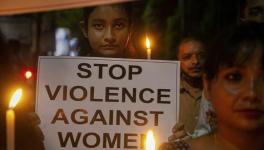Pornography, Populism and the Rape Culture

The 77th anniversary of India’s Independence was marked by women taking to the streets, protesting sexual violence and reclaiming the night.
Powerful images of protests emerged from across the country. The protests were triggered by the rape and murder of a postgraduate trainee doctor on duty at the R.G. Kar Medical College and Hospital, Kolkata on August 9.
This is no cause for celebration. In fact, it should be worrying that almost eight decades after the country gained Independence, women still have to organise to reclaim time and space that should be universally accessible. Moreover, these peaceful demonstrations were met with the usual State response— tear gas and lathi charges.
The National Crime Records Bureau (NCRB)’s 2022 report puts the number of rapes at 90 every day. And these are just the reported numbers. Sexual and intimate violations without consent are a common occurrence globally. Rape, by virtue of being so common, becomes socially unobtrusive.
What is rape culture?
Rape culture can be defined as a deliberate system of intimidation where men keep women in a constant state of fear through the pervasive normalisation of violence against women.
It should be worrying that almost eight decades after the country gained Independence, women still have to organise to reclaim time and space that should be universally accessible.
An extension of this is the fact that in this culture, to be socially obtrusive, an incident of rape needs to provide some rasa to the ‘consumer’ — bībhatsa, bhayānaka or karuna, to be consumed and derived the respective values from. These emotions are not just organic reactions but are rather deliberately cultivated to create a consumable narrative that caters to a voyeuristic audience.
The first thing worth noting in this consumerist nature of rape culture is that there is always an ideal victim. As Prof. Mrinal Satish, professor and dean of research at the National Law School of India University, Bengaluru, also notes, there is a perpetuating image of an ‘ideal’ rape victim. She is, inter alia, chaste (i.e., either a ‘virgin’ or married), is attacked by a stranger, resists her offender, and is badly injured (or killed) in the process.
The more the incident matches the description of the ideal, the more likely is it to be believed and responded to. In the present case, the repeated invocation of the memory of Nirbhaya is an obvious manifestation of the nostalgia of the past outrage. The logical inference would be that this invocation of nostalgic memories stems from the search (read: requirement) of an ideal victim. Hence, the threshold of sparking outrage among the people is raised with each such incident.
It is noteworthy that much of the media coverage consistently referred to her as a ‘young’ doctor, despite her age. This choice of language is not incidental; it reflects a deeper societal tendency to infantilise women based on their marital status and perceived ‘youth’.
As feminist writer and activist Susan Sontag astutely observed decades ago, aging is often viewed as enhancing a man while it progressively diminishes a woman. In India, social norms dictate that women should marry early, lest they become ‘too old’ to be considered acceptable.
Yet, there is an ironic flip in the public portrayal of this victim, where her ‘youth’ is emphasised despite her being 31 years old, as if to preserve a certain narrative. Age and the politics of respectability have been reflected in how a victim is referred to beyond mere descriptors of empty relationships that do not protect women from being raped.
For women, age is not merely a number but a marker of their perceived value in a patriarchal society— a society where womanhood is constantly constructed and reconstructed by male-dominated narratives. This is echoed in writer and intersectional feminist Audre Lorde’s exploration of differences, where the social construction of womanhood is wielded to control and define women’s identities, often to their detriment.
In this case, the victim’s portrayal as ‘young’ serves to highlight how societal perceptions continue to shape our understanding of women, even in death. Her identity is not allowed to simply exist; it must be filtered through the lens of her ‘youth’, an unspoken nod to her unmarried status.
Another significant factor to take into account to properly understand rape culture is the role of the State and the media. While on one hand the State claims parens patriae jurisdiction, we receive news reports about rape offenders in two, polar opposite manners. Either there will be the news of the State going all-out, seeking to impose capital punishment (or worse, effectuating extra-judicial killings), or we will have instances of what seems like investigative cover-ups or leniency in sentencing.
Our intent is to highlight two key points. First, although there is no mandatory death penalty for rape simpliciter, aggravated forms of rape may warrant it.
In cases involving murder, the law prescribes life imprisonment or the death penalty. When both rape and murder occur, the court considers the crime exceptionally severe. Over the past twenty years, the death penalty has been carried out in only two types of offenses: terrorism-related crimes— Ajmal Kasab, Yakub Menon and Afzal Guru— and cases involving rape and murder— Dhananjay Chatterjee and the convicts of the Delhi 2012 incident.
Rape, by virtue of being so common, becomes socially unobtrusive.
While comprehensive safeguards are essential for the effective prosecution of sexual offences, the death penalty is not one of them. The Justice Verma Committee Report, which shaped the 2013 amendments to sexual offence laws, described the deterrent effect of the death penalty as “a myth”, arguing that applying it in non-homicidal cases would be regressive.
Women’s rights groups contend that the death penalty in rape cases is an impulsive, populist response that perpetuates the patriarchal domestication and victimisation of women.
Civil rights activist K. Balagopal has condemned the regressive nature of capital punishment, arguing that society should focus on addressing the underlying social and political issues that contribute to crime, rather than depending solely on harsher punishments.
Populist legislative amendments responding to public outrage, coupled with judicial endorsement of the death penalty on the flawed basis of ‘collective conscience’, legitimise the simplistic notion of harsher punishment for harsher crimes. This approach evades the real task of social reorganisation necessary to eradicate the rape culture ingrained in our society by systemic patriarchy.
How badly an incident offends and disturbs this ‘collective conscience’ of the electorate is a crucial factor in determining the outcome of the case. This connects to the next part of our argument about manufacturing the discourse around rape.
There is a visible pornification of the reporting in all cases of sexual abuse, particularly rape. The use of disturbing narrations and violent imagery is the most unnecessary yet descriptive details of violence— replicating nothing but rape culture. It has been twelve years since the Nirbhaya case, which was reported similarly, and triggered comparable outrage.
The media’s portrayal of rape often shifts from a necessary reporting of facts to a form of entertainment, either as sadistic pleasure or masochistic empathy, that satisfies a consumerist demand for emotional engagement.
This commodification of rape ultimately reinforces rape culture, reducing the crime to yet another spectacle for public consumption. This is usually bracketed under the broad term ‘sensationalism’— implying that the media discusses this issue in this manner because it attracts attention and viewership, and hence is normal reporting.
This is damaging in two very distinct ways— one, it completes the demand–supply cycle of those ‘details’, which in the usual market-based competition results in a more details-specificity and vividness competition of reporting, which borders pornographic vividity.
Therefore, the incident gets reduced to a medium of supplying pornographic vividity to the consumers who indirectly (and sometimes, directly) demand it.
The first thing worth noting in this consumerist nature of rape culture is that there is always an ideal victim.
Two, this links back to the previous points about the ideal victim stereotype and the outrage threshold. The victim’s identity, profession, location (urban or rural), the severity of the violence and the surrounding circumstances are often used to categorise gendered violence and obscure the reality of rape.
The pornification of rape reporting also means that where either the victim-survivor fails to meet the standards of the ideal, or the incidents themselves are not violent and brutal enough, the incident fails to gain the requisite amount of attention.
In other words, only the ‘unacceptable’ forms of rape demands outrage. This reinforces the notion of rape being ‘rough or violent sex’ instead of ‘violence using sex’, making the affair more about sex than violence, and hence redirecting the protective and preventive measures in the wrong direction.
These preventive measures begin with the domestication of women in the name of protection, and are in turn perpetuated using either violence, or the threat thereof.
Ironically, one of the manifestations of this domestication using violence is marital rape. This further permeates in the workplace. Gendered relations are replicated and maintained throughout spaces that one might normatively distinguish as public, private and professional.
The National Medical Commission has directed healthcare institutes and medical colleges to enforce the Sexual Harassment of Women at Workplace (Prevention, Prohibition and Redressal) (PoSH) Act, 2013; yet in this case— where a doctor was brutally raped and murdered on duty— the issue of workplace sexual harassment has been barely addressed.
As feminist legal scholar Catherine Mackinnon writes, “Working women have been subject to the social failure to recognise sexual harassment as an abuse at all.
“Tacitly, it has been both acceptable and taboo; acceptable for men to do, taboo for women to confront, even to themselves.”
Sexual harassment at work and extreme sex-based violence are linked to pornography. Media sensationalism often obscures the connection between widespread pornography and sex-based violence, hostility, and discrimination.
Studies, including feminist writer and activist Diana E.H. Russell’s Pornography and Rape: A Causal Model, demonstrate the correlation between pornography and sexual aggression, underscoring pornography’s broader impact beyond moral debates.
The issue can then be traced with the legal and discursive problematisation of pornography itself. The normative legal framework treats pornography primarily as a victimless crime— a moral issue rather than a matter of personal harm or public safety.
It is noteworthy that much of the media coverage consistently referred to her as a ‘young’ doctor, despite her age.
The primary concern of obscenity laws has been to maintain a community’s moral standards, often neglecting the harmful impacts of pornography on individuals and society.
By focusing on moral purity, these laws overlook the ways in which pornography can contribute to sexual harassment, rape and other forms of sexual brutality.
As a result, sexual violence is frequently dismissed as a personal moral failing rather than recognised as part of a broader pattern of inequality and exploitation. This moral framing prevents a deeper understanding of the structural issues that allow such violence to persist, reinforcing existing power dynamics.
Ad hocism won’t work
Therefore, to defeat the rape culture is to defeat the structures of consumerism, where the severity or importance of rape is measured by the voyeuristic value it creates for the consumer.
If the problem is so deeply rooted in culture and popular discourse, it is meaningless to talk about ad hoc solutions. The penal law, however integral it may be, still remains an inadequate tool to deal with this problem.
The infrastructure of rape culture is bolstered by populism, which thrives on the public’s appetite for vivid descriptions and calls for brutal, medieval punishments, further distorting public perception and reinforcing harmful narratives.
As long as the media continues to prioritise sensationalism over factual reporting, and society fails to address the underlying issues of sexual harassment and violence, particularly in spaces such as the workplace, these harmful narratives will persist.
Addressing the broader implications of pornography and its connection to sexual aggression is crucial in reframing the discourse around rape and sexual harassment. The challenge lies in shifting the focus from compliance and moral debates to a serious engagement with the legal and societal structures that perpetuate these issues, ensuring that the protection and dignity of women are upheld in all spheres of life.
Women’s rights groups contend that the death penalty in rape cases is an impulsive, populist response that perpetuates the patriarchal domestication and victimisation of women.
The fact that rape videos related to the Kolkata doctor case are trending on porn sites reveals a disturbing facet of our society. This is not just an isolated search but a reflection of how deeply ingrained voyeuristic tendencies have become in the wake of sexual violence.
The brutal rape and murder of a young doctor in Kolkata has once again triggered a morbid curiosity, where the violation itself becomes a consumable spectacle. Disturbingly, this is not the first time such a trend has emerged.
After the horrific rape and murder of a veterinary doctor in Telangana, and even following the brutalisation of an eight-year-old girl in Kathua, searches for videos related to these crimes surged online.
Even more troubling is that these are not just one-off instances; ‘forced sex’ and ‘rape videos’ remain among the most searched terms on porn sites in India.
These patterns expose the infrastructure of rape culture, where the intersection of pornography and populism normalises the objectification and commodification of violence against women.
If the problem is so deeply rooted in culture and popular discourse, it is meaningless to talk about ad hoc solutions.
The public’s appetite for such content only strengthens the very structures that perpetuate these crimes, turning rape into something that is not just lived and endured but consumed, dissected, and ultimately, trivialised.
Sagrika Rajora graduated from the Jindal Global Law School in 2023 and has been actively involved in mobilising community action since their student years, working with sex workers, domestic workers and trade unions.
Aditya Krishna lives in Darbhanga (Bihar) and is an independent researcher graduating from the National Law School of India University, Bengaluru in 2023.
Get the latest reports & analysis with people's perspective on Protests, movements & deep analytical videos, discussions of the current affairs in your Telegram app. Subscribe to NewsClick's Telegram channel & get Real-Time updates on stories, as they get published on our website.
























